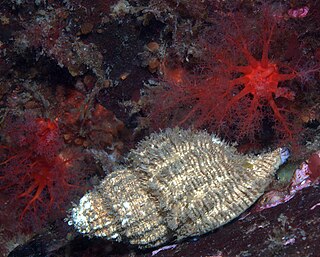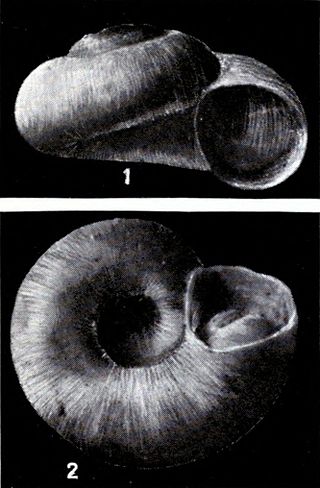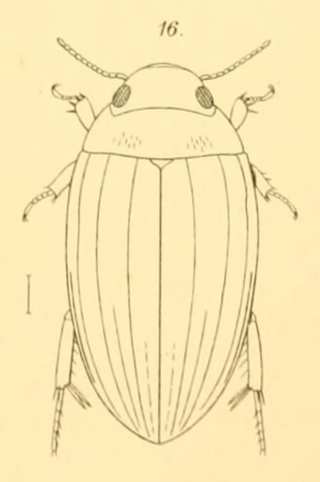Related Research Articles

The Dytiscidae – based on the Greek dytikos (δυτικός), "able to dive" – are the predaceous diving beetles, a family of water beetles. They occur in virtually any freshwater habitat around the world, but a few species live among leaf litter. The adults of most are between 1 and 2.5 cm (0.4–1.0 in) long, though much variation is seen between species. The European Dytiscus latissimus and Brazilian Megadytes ducalis are the largest, reaching up to 4.5 cm (1.8 in) and 4.75 cm (1.9 in) respectively. In contrast, the smallest is likely the Australian Limbodessus atypicali of subterranean waters, which only is about 0.9 mm (0.035 in) long. Most are dark brown, blackish, or dark olive in color with golden highlights in some subfamilies. The larvae are commonly known as water tigers due to their voracious appetite. They have short, but sharp mandibles and immediately upon biting, they deliver digestive enzymes into prey to suck their liquefied remains. The family includes more than 4,000 described species in numerous genera.

Fusitriton oregonensis is a species of large predatory sea snail, a marine gastropod mollusk in the family Cymatiidae.

Desmatophoca is an extinct genus of early pinniped that lived during the Miocene, and is named from the Greek "phoca", meaning seal. A taxon of the family Desmatophocidae, it shares some morphological similarities with modern true seals. Two species are recognized: Desmatophoca oregonensis and Desmatophoca brachycephala. Little information exists regarding Desmatophoca, due to the small number of fossil samples obtained and identified.

Bennettazhia is a genus of tapejaromorph pterosaur which lived during the Albian stage of the Early Cretaceous from what is now the Hudspeth Formation of the state of Oregon in the United States. Although originally identified as a species of the pteranodontoid pterosaur Pteranodon, Bennettazhia is now thought to have been a different animal. The type and only species is B. oregonensis.

Megadytes ducalis is a species of water beetle in the family Dytiscidae. It is the largest species in the family. Until recently, the species was only known from a single specimen that was collected in the 19th century from Brazil, but more specimens, also collected in the 19th century from Brazil, were discovered in 2019. Although listed as extinct by the IUCN, the limited studies conducted on water beetles in Brazil means that it might still survive.

Valvata oregonensis is a species of fossil freshwater snail with a gill and an operculum, an aquatic gastropod mollusk in the family Valvatidae, the valve snails.
Hydrotrupes is a genus of beetles in the family Dytiscidae, containing the following species:
Copelatus galapagoensis is a species of diving beetle. It is part of the genus Copelatus in the subfamily Copelatinae of the family Dytiscidae. It was described by G. R. Waterhouse in 1845.
Copelatus gardineri is a species of diving beetle. It is part of the genus Copelatus in the subfamily Copelatinae of the family Dytiscidae. It was described by Hugh Scott in 1912.

Copelatus glyphicus is a species of diving beetle. It is part of the genus Copelatus in the subfamily Copelatinae of the family Dytiscidae. It was described by Say in 1823.

Copelatus pandanorum is a species of diving beetle. It is part of the genus Copelatus in the subfamily Copelatinae of the family Dytiscidae. It was described by Hugh Scott in 1912.
Actinidia oregonensis is an extinct species of flowering plants in the kiwifruit family, Actinidiaceae, solely known from the middle Eocene sediments exposed in north-central Oregon. The species was first described from a series of isolated fossil seeds in chert.
Paleopanax is an extinct genus of flowering plant in the Ginseng and Ivy family, Araliaceae, containing the single species Paleopanax oregonensis. The species is solely known from the middle Eocene sediments exposed in north central Oregon and was first described from a series of isolated fossil fruits in siltstones.
Carabdytes plantaris is a naturally uncommon species of diving beetle in the family Dytiscidae. It is endemic to New Zealand. For over a century, it was known from just a single specimen collected in 1880 "near Dunedin", and doubts were cast on whether it was actually a New Zealand species at all. In 1986, it was rediscovered when several were collected from a roadside pond near Lake Ellesmere. Carabdytes plantaris is now classed as "naturally uncommon" by the Department of Conservation.
Agabus klamathensis is a species of predacious diving beetle belonging to the family Dytiscidae. This species is found in springs, creeks, rivers, and pools in northern California and southwestern Oregon.
Deretaphrus is a genus of dry bark beetles in the family Bothrideridae. A taxonomic revision of the genus published in 2013 listed 25 species, which exhibit a disjunct distribution. There are 22 species of the genus described from Australia, with single species also being found in each of New Caledonia, Bolivia, and North America.

Novumbra oregonensis is an extinct species of mudminnow from Oregon, USA. All fossils have been found in the lower member of the John Day Formation; the type specimens were found in the Knox Ranch leaf locality, and additional paratypes were found in the Bridge Creek flora locality. Similar to other mudminnows, its habitat would have been heavily vegetated waters, based on the presence of leaf imprints accompanying the fossils.
Hydrovatus castaneus, is a species of predaceous diving beetle found in India, Myanmar, Indonesia, Sri Lanka, Bangladesh, and China.
Hydrovatus picipennis, is a species of predaceous diving beetle found in India, Sri Lanka, Indonesia, Philippines, China and Thailand.
Hydrovatus rufoniger, is a species of predaceous diving beetle found in India, Bangladesh, Myanmar, Sri Lanka, China, Sumatra, Malaysia, Singapore, Thailand, Vietnam and Australian region.
References
- ↑ Dytiscidae Species List at Joel Hallan's Biology Catalog. Texas A&M University. Retrieved 7 May 2012.
- ↑ Kanda, Kojun; Gomez, R. Antonio; Van Driesche, Richard; Miller, Kelly B.; Maddison, David R. (16 November 2016). "Phylogenetic placement of the Pacific Northwest subterranean endemic diving beetle Stygoporus oregonensis Larson & LaBonte (Dytiscidae, Hydroporinae)". ZooKeys (632): 75–91. doi: 10.3897/zookeys.632.9866 . ISSN 1313-2970. PMC 5126547 . PMID 27920606.